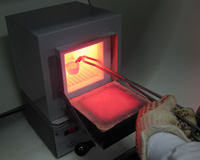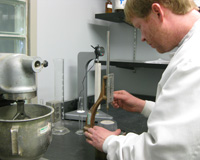



A Highbridge chemist melting portland cement in a high temperature furnace. The melt is quenched to a glass and then dissolved in concentrated acid in preparation for elemental measurement through atomic absorption spectroscopy.
A carefully mixed and molded cement sample is tested for its initial set time using the Vicat needle. The sample shown here is a natural cement requiring much more rapid and accurate measurement by the technician.
Cement Properties and Performance
Most hydraulic cements and supplementary cementitious materials have both chemical and physical property requirements designed to carefully control their performance or categorize them into specialty types for different applications. These tests may be used as routine quality assurance measures as part of a project specification. They may also be called upon when a concrete or mortar containing the raw material is not performing as expected. Chemical limits are often set on elements such as chloride, sulfate, or alkalis. Physical performance may be tested through measurements of set time, autoclave expansion, or strength.
Highbridge chemists use qualified atomic absorption spectroscopy methods to measure the elemental composition of cement, calculate the estimated Bogue phase composition, and compare values against mill certificates. Physical testing is performed by our technicians in a fully equipped and dedicated cement testing laboratory.
